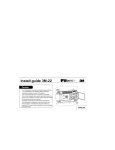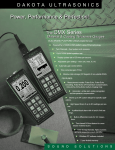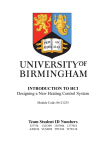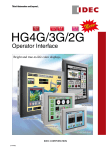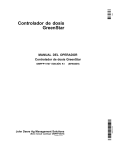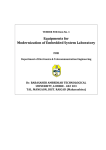Download A Low-Cost Intelligent Thermostat Incorporating a Learning
Transcript
A Low-Cost Intelligent Thermostat Incorporating a Learning Algorithm Based Scheduler and Internet Accessible Control Interfaces 1 M.M. A. Rahman, D. Huizenga, 2E. Chiaburu 1 School of Engineering, Grand Valley State University, Grand Rapids, MI 2 Gentex Corporation, Zeeland, MI Email: [email protected] Abstract This paper presents an internet connected programmable thermostat that automatically generates an energy efficient heating and cooling schedule through the collection and analysis of occupancy data. The implementation provides an easy to use color touch screen, an on-device browser accessible web interface, and an Android smartphone interface. In this capstone project work, the proposed system was developed and the proposed features were validated using a commercial PIC32 development board. The novel features of the Intelligent Thermostat represent a substantial evolution of thermostat technology. Currently, no commercial thermostat is available that provides automatic scheduling capability, and no commercial thermostat is available that serves a web connection feature from the device itself. The only announced commercial thermostat with automatic scheduling capability is slated to cost substantially more than the Intelligent Thermostat. The fully automated energy savings capabilities of the Intelligent Thermostat will save the average homeowner thousands of dollars over the life of the hardware and, with widespread deployment, could eliminate the emission of millions of tons of CO2 annually. Given the easily available energy savings with virtually no impact on a homeowner’s quality of life, it is believed that automatic scheduling thermostats represent the future standard in programmable thermostat technology. Introduction According to US EPA research, the average household in the United States spends about $2200 per year on energy [2]. Of this, approximately 50% is spent on heating and cooling. The US DOE calculates that a savings of 1% can be achieved for each degree that a programmable thermostat is set back during a period of at least eight hours. In total, a heating and cooling schedule that meets US EPA guidelines will save the average US household about $180 per year [3]. Prior to the implementation of this project, numerous Internet-connected programmable thermostats were surveyed. Even the most advanced thermostats had shortcomings: (1) they required the user to complete a tedious programming process to take advantage of energy saving heating and cooling scheduling capabilities, (2) internet connectivity was achieved through connection to the manufacturer’s server network, limiting future utility of web connection features to the window during which the manufacture continued to maintain the server network, (3) thermostats with modern color touch screen user interfaces and web connectivity retailed for in excess of $300. These limitations have resulted in limited adoption of programmable thermostats and limited utilization of programmability even in those cases where a programmable thermostat is installed. In fact, a study conducted in Connecticut found that only 36% of the homes within the test group (who had been provided with programmable thermostats free of charge) were using the automatic temperature setback capability of the thermostat [1]. The Intelligent Thermostat solves each of these problems with unique features that were not Proceedings of the 2014 ASEE North Central Section Conference Copyright © 2014, American Society Engineering Education found in any announced or available commercial thermostat when this project was started: (1) The Intelligent Thermostat completely automates schedule generation, and as a result, automates energy savings (2) The Intelligent Thermostat hosts the web server for the Internet interface on the device, eliminating dependency on the continued availability of third party servers, (3) The materials cost for a custom hardware implementation of the Intelligent Thermostat would be approximately $110 per unit (without considering volume discounts), (4) In addition, the Intelligent Thermostat is designed to achieve parity with the standard scheduling and temperature control features provided by more expensive units, (5) Using the EPA estimates, the cost breakeven point for the Intelligent Thermostat occurs after less than 10 months of use. (6) Since the Intelligent Thermostat is able to automatically tailor its schedule to the user, and provides remote override capability for unscheduled occupancy, it is configured by default to use more aggressive setbacks than the EPA standards. As a result, the Intelligent Thermostat should exceed EPA energy savings, further accelerating breakeven. Market Survey: Programmable Thermostats A market survey was conducted to determine the state of the art for energy saving thermostats. When this project was started, two thermostats stood out as providing more advanced features and capabilities than those offered by typical programmable thermostats: the Honeywell Prestige HD 2.0 with optional RedLINK Internet gatway, and the Ecobee EB-STAT-02. In addition, two other thermostats are presented here: The Nest Learning Thermostat and the 3M Filtrete WiFi Programmable Thermostat. The Nest (which was announced during development of the Intelligent Thermostat) provides a learning capability similar to that of the Intelligent Thermostat, while the 3M Filtrete WiFi Programmable Thermostat was the lowest cost webconnected thermostat found during the survey. Table 1 compares these thermostats to the implemented Intelligent Thermostat. Table 1 Commercial Thermostat Comparisons Proceedings of the 2014 ASEE North Central Section Conference Copyright © 2014, American Society Engineering Education Block Diagram of Intelligent Thermostat This advanced thermostat has four implementation areas: firmware, web interface, android app, and hardware. A block diagram depicting the functional interfaces among these implementation areas is presented in Fig. 1. Figure 1 Intelligent Thermostat block diagram Thermostat Firmware The thermostat firmware provides many core features to the Intelligent Thermostat. It is responsible for: controlling the HVAC system, maintaining the data stores that back the automatic schedule generation algorithm, automatically generating the intelligent HVAC schedule, executing HVAC schedules, serving the Web interface, executing the local touch screen User Interface, and executing an HTTP based Remote Procedure Call application supporting multiple simultaneous clients. Detailed information on the firmware’s feature set and the underlying implementation is available in [17] and beyond the presentation scope of this paper. Occupancy Sensor Network and Schedule Generation The HVAC Intelligence Module is responsible for system mode transitions, collecting and logging occupancy sensor network data, and automatic schedule generation based on occupancy logs. The Intelligence Module supports a total of 8 system modes, which automatically reconfigure the thermostat’s internal state to achieve a desired behavior. The available system modes are detailed in the Table 2. The Intelligence Module’s automatic schedule generation functionality has four primary stages: data combination (based on analysis group numbers), occupancy probability generation, probability threshold application, and schedule windowing application. A flowchart describing the automatic schedule generation algorithm is presented in Figure 2. Proceedings of the 2014 ASEE North Central Section Conference Copyright © 2014, American Society Engineering Education Table 2 HVAC System Modes Figure 2 Automatic schedule generation algorithm Proceedings of the 2014 ASEE North Central Section Conference Copyright © 2014, American Society Engineering Education Web Interface and Android Application The web interface is served by the thermostat firmware in response to HTTP requests to its root directory. The web interface provides: set-point and mode management; graphical manual schedule creation and editing; and thermostat configuration editing. Android OS is 100% open platform and was used for remote access. The goal of the Android application was to allow users easy access to all thermostat features from anywhere using their Android smartphone. The application had to be easy to use, yet capable of modifying the thermostat’s more advanced settings. Detailed information about these functions is available in [17]. Hardware Implementation and Results During hardware selection, a survey was performed of the available microcontroller architectures, supporting software toolsets, and available development boards. The PIC32MX7 architecture stood out in particular because it offered microcontrollers that provided sufficient resources to implement the desired feature set, an integrated MAC, low cost, and a commercial quality IDE with a generous trial period. After selection of a platform, a survey was conducted of available development boards, and the MicroElektronica MultiMeda Board (MMB) for PIC32MX7 was selected. This board offered the following features needed to implement the Intelligent Thermostat demonstration: · PIC32MX795F512L based design · QVGA touchscreen · Ethernet phy + RJ45 port · LEDs for simulation of HVAC outputs · Switch for simulation of occupancy input · Integrated temperature sensor · In-Circuit debugging and programming capability · Additional peripherals for potential capabilities growth (SD card support, audio codec, onboard EEPROM and flash, etc.) Details on the development board components and implementation are available in [17]. Proposed intelligent thermostat with all desired features was successfully demonstrated on the development board and some of the pictures taken from the demonstrated prototype are provided in Fig. 3. Conclusions A low-cost, web connected and smartphone accessible, Intelligent Thermostat capable of creating operating schedule based on learning algorithm was designed and implemented on a PIC32development board. The novel features of this capstone project on the Intelligent Thermostat represent a substantial evolution of thermostat technology. Currently, no commercial thermostat is available that provides automatic scheduling capability and that serves a web connection features from the device itself. The only announced commercial thermostat with automatic scheduling capability is slated to cost substantially more than the Intelligent Thermostat. The fully automated energy savings capabilities of the Intelligent Thermostat will save the average homeowner thousands of dollars over the life of the hardware, and with widespread deployment, could eliminate the emission of millions of tons of CO2 annually. Given the easily available energy savings with virtually no impact on a homeowner’s quality of life, we believe that the learning algorithm based automatic scheduling thermostats represent the future standard in programmable thermostat technology. Proceedings of the 2014 ASEE North Central Section Conference Copyright © 2014, American Society Engineering Education Figure 3(a) Configuration editor Figure 3(c) Direct control view Figure 3(b) Application welcome screen Figure 3(d) Set temperature dialog Proceedings of the 2014 ASEE North Central Section Conference Copyright © 2014, American Society Engineering Education Figure 3(e) Add schedule dialog Figure 3(g) Add transition dialog Figure 3(i) Temperature and humidity graph Figure 3(f) Schedule list context menu Figure 3(h) Edit transition dialog Figure 3(j) HVAC and occupancy graph Proceedings of the 2014 ASEE North Central Section Conference Copyright © 2014, American Society Engineering Education Bibliography 1. David Cross and David Judd. Consortium for Energy Efficiency. [Online]. http://www.cee1.org/eval/db_pdf_es/953es.pdf 2. U.S. Environmental Protection Agency. (2011, Dec.) Programmable Thermostats: ENERGY START. [Online]. http://www.energystar.gov/index.cfm?fuseaction=find_a_product.showProductGroup&pgw_code=TH 3. U.S. Department of Energy. (2011, Dec.) Energy Savers: Thermostats and Control Systems. [Online]. http://www.energysavers.gov/your_home/space_heating_cooling/index.cfm/mytopic=12720 4. (2011, Dec.) Prestige TH9321 Operating Manual. [Online]. http://customer.honeywell.com/techlit/pdf/PackedLit/69-2493EFS.pdf 5. Ecobee. (2011, Dec.) SMART THERMOSTAT User Manual. [Online]. http://www.ecobee.com/wp-content/themes/ecobee/etc/file/UMR5-041510web.pdf 6. Nest. (2011, Dec.) Nest Support. [Online]. http://support.nest.com/ 7. 3M. (2011, Dec.) Operation Guide 3M-50. [Online]. http://www.radiothermostat.com/filtrete/guides/3M-50-Operation-13may10.pdf 8. (2011, Dec.) PexSupply.com. [Online]. http://www.pexsupply.com/Honeywell-THX9421R5013-Prestige-IAQ-20-HD-Comfort-Thermostat 9. (2011, Dec.) pexsupply.com. [Online]. http://www.pexsupply.com/Honeywell-THM6000R1002-RedLINKInternet-Gateway 10. (2011, Dec.) Amazon.com. [Online]. http://www.amazon.com/Ecobee-EB-STAT-02-Enabled-InternetThermostat/dp/B004150PJG/ref=sr_1_1?ie=UTF8&qid=1323131122&sr=8-1 11. (2011, Dec.) Nest Store. [Online]. http://store.nest.com/ 12. (2011, Dec.) The Home Depot. [Online]. http://www.homedepot.com/ 13. (2011, Dec.) Java, Eclipse, Android, and Web Programming Tutorials. [Online]. http://www.vogella.de/android.html 14. Rito Meier, Professional Android 2 Application Development, 2nd ed., Milan Shah, 46 Ed. Indianapolis, IN: Wiley, 2011. 16. US EPA. (2011) Encouraging Energy Efficiency in New and Existing Homes. 17. (2012) E. chiaburu, et.al An Implementation of a Low Cost Intelligent Thermostat Incorporating a Learning Algorithmic Scheduler and Internet Accessible Control Interfaces Capstone project report. Proceedings of the 2014 ASEE North Central Section Conference Copyright © 2014, American Society Engineering Education








